Thornton D in lignum vitae Review
(Review written January 2018)
Preface
When Tommy posted on Facebook about some whistles he had finished, the look of the lignum vitae really caught my eye. Lignum vitae is one of the species of wood also called "ironwood". I'd never played a Thornton whistle before, and this seemed a great opportunity to try a new whistle with a wood I've never had in a whistle before. And boy, am I glad I did! As a side note, my whistle has Turkish boxwood rings instead of the standard imitation ivory.
At a Glance
Whistle Reviewed: Thornton D in lignum vitae
Models Available: D, E flat, C and B natural in Hardwood. Bb and A are reported to be available in spring of 2018.
Construction: Hardwood body Delrin head. Brass and imitation ivory fixtures.
Price at time of review: $250
Available From:
Thornton Whistles
How Acquired: Purchased from Tommy Martin.
Appearance
Beautiflly crafted whistles. The ferrule on the end is really unique and reminds me of the end of the chanter on an uilleann pipe. It's just a little more ornate than the ring that most makers will use (if they put a ferrule on at all). The lignum vitae is gorgeous, and has a really complex grain pattern. I have no complaints at all.
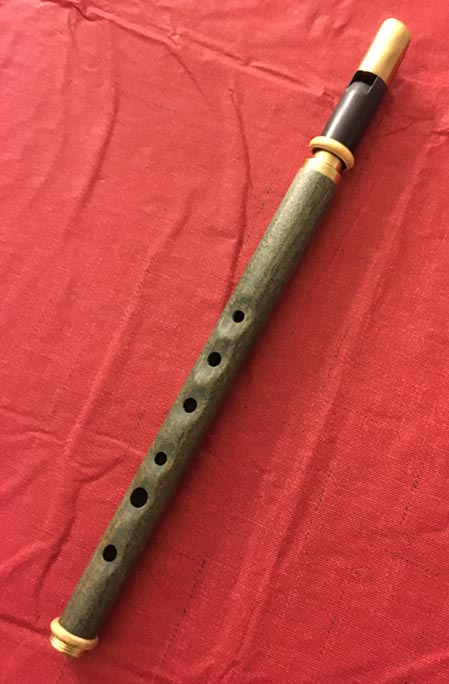
A full shot of the whistle. I really like the way these look! It's probably impossible to tell from the photo, but the body is slightly tapered. Not nearly as conical as a Clarke, but it's there, if subtle. Tommy's website reports that the bore is tapered as well, to help with the inevitable compromises that whistlemakers have to make when designing cylindrical-bore whistles.
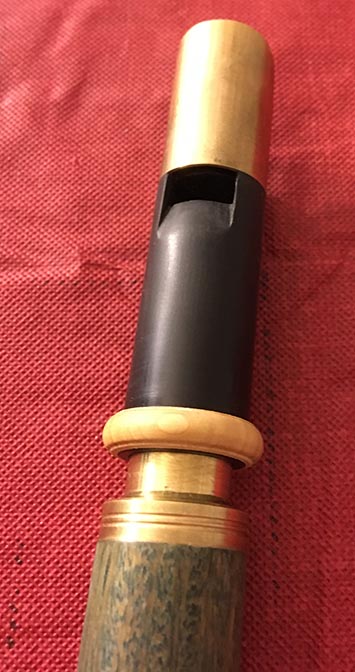
A shot of the head of the whistle. You can see the brass fixtures and tuning slide, as well as one of the decorative rings. It's a class act. But look at that sound hole! It's huge! That's probably why this whistle is so loud. And it's loud!
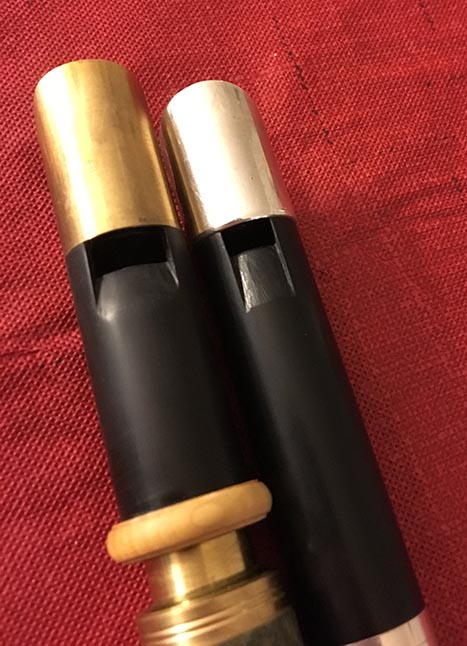
As a comparison, here's the Tornton side-by-side with my Abell. That windway is probably twice as wide. Still, it's well made and nicely finished.
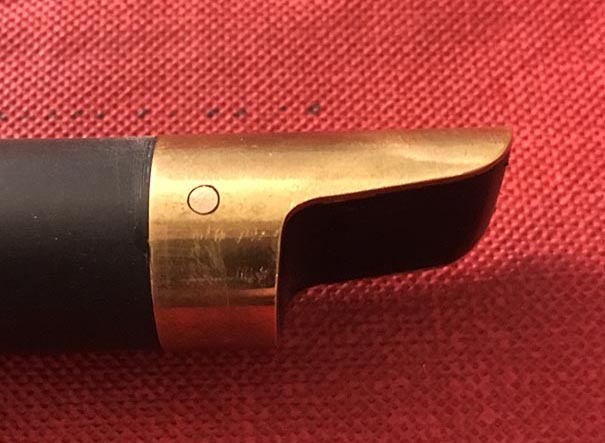
Another shot of the head. Unlike many high-end whistles, the Thornton has a good long beak. This will be welcome news to people who don't like the stubbier beaks found on a number of high-end whistles. The mouthpiece has a single brass pin holding it in place. It's polished flush, and I can't feel it with my fingers. I've owned a number of whistles where the glue has failed on the metal fixtures (mouthpiece, end ferrule, etc). It's not a big deal to glue them back myself, but I don't think I'll have to worry about it with this one.
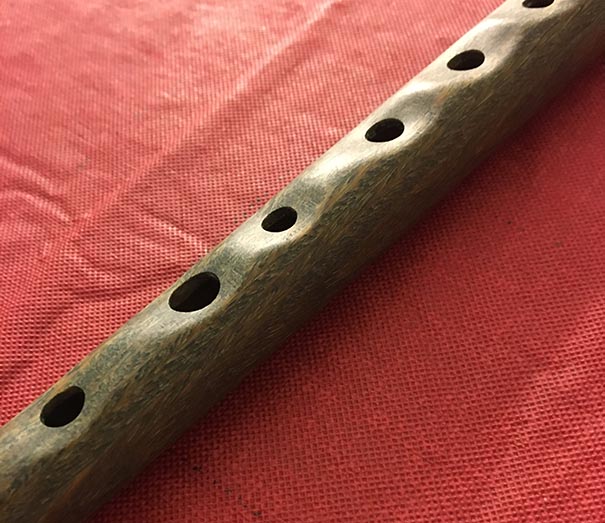
I wanted to get a good angle with some nice reflection to show the scalloped holes and the beautiful grain pattern of the wood. This took me all of about 10 minutes to get used to. The holes are more "flattened" than "scalloped" and when I first played the whistle, I didn't get good coverage of the holes because I couldn't feel them tactically like I can with a regular whistle. So I squeaked it. But I grew used to the feel of the instrument extremely quickly and was ready and able to play it at session just a few days later without any embarrassing mishaps.
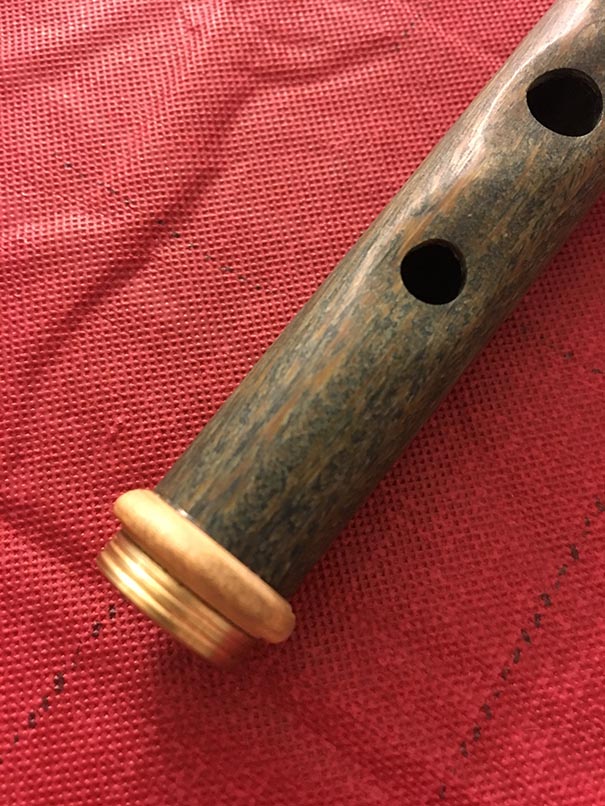
A shot of the bottom of the whistle, showing another decorative ring and the ferrule. Without the ring, that ferrule would probably look like a simple ring at the bottom just like any other maker's whistle. But that ivory ring really transforms the look in my opinion, and for the better.
Playing Characteristics
Video clips of the whistle:
http://tinwhistler.com/music/video/wind ... ornton.mp4
Tone: Mostly pure, with a slight woodsy chiff. Unlike other large-windway whistles (like say, the Clarke original), you don't get the big whooshy windy sound. The sound is crisp, clear, with just the right amount of complexity.
Volume: Loud. LOUD. Your deaf aunt can probably hear this whistle just fine. Seriously, this is a loud whistle. At my loud session, I used to bring out my Oz whistle when I needed to lead a tune and nobody could hear even the Abell. But this whistle wins the prize. I've played it exclusively at the last few sessions I've been to, because they've been banjo and concertina heavy. And it stood up to them just fine. If I still worked at the Renaissance Festival, this is the whistle I'd be playing outdoors to help the tune carry.
Responsiveness: Quick.This whistle is just as quick as my Abell, Oz, or Copeland. I have no issues at all playing whatever ornaments I want without muddiness.
Tuning: When tuned to A=440, this whistle is in tune up the scale, with gradually increasing breath. No special adjustments necessary for unruly notes. That said, when I blow the second octave as hard as I think I need to, I tend to be about 15 cents sharp, so I'm going to have to learn that (unlike all of my other loud instruments) the second octave takes a lighter touch.
C-natural: OXXOOO makes a perfect C-Natural. All of the other alternative fingerings I know leave the whistle extremely flat (30-40 cents).
Hole size and placement: The holes are centered on the whistle and fairly evenly spaced--though, like with most whistles, there's a small gap between F# and G, and the E and F# holes are a little closer together. But unlike most whistles I own, the holes are all very close to the same size. The E hole on my Thornton is considerably smaller than the E hole on my Abell. This is good news for people with small fingers who might have trouble sealing a standard whistle.
Air volume requirements: High. Like Clarke Original high. As a comparison, I grabbed my Clarke out of the whistle drawer and played them back to to back. I ran out of air on the Clarke first, but I only managed to get 2 or 3 more notes out of the Thornton on the same amount of breath. This would have been a deal-breaker for me at one time, but I'm at a place in my playing now where I'm a lot more comfortable finding new places to breathe. It might put beginners off of the instrument, though.
Air pressure requirements: Medium, tending to high. The whistle doesn't take nearly as much pressure as I would've expected, and if you really lean into the second octave, you're going to blow way sharp (as I note above in the Tuning section).
Clogging: None whatsoever. But that's not really that surprising with a whistling moving that much air through such a large windway.
Wind Resistance: Good. I haven't really had the opportunity to play this in really gusty winds yet, but I haven't had any problems playing it outdoors. Some whistles die with the slightest breeze. This one seems fine for ordinary weather conditions.
Summary
This is a loud whistle, and it takes a fair bit of breath. More than I've needed to use in a whistle in a long time. That said, it's quickly replaced my Abell as my go-to whistle at session. It's a great performer, doesn't clog, and is loud as heck. I thought my Oz whistle was the loudest I'd ever owned, but this one has it beat hand's down. And when you play between a banjo player and a box player in a rowdy bar (as I often do), you need something that can really punch through if you're leading the tunes.